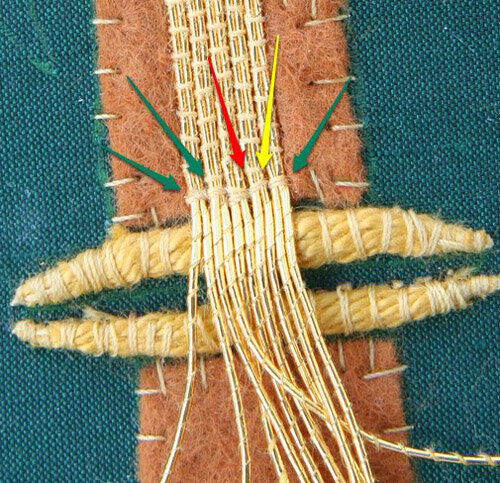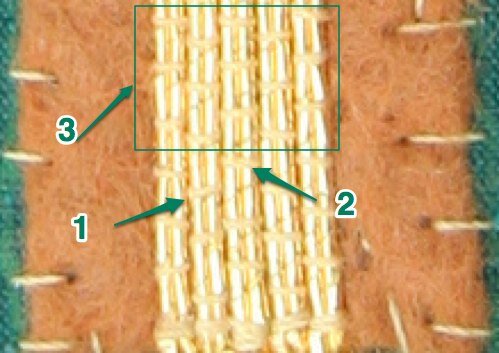RSN Goldwork Day 2: Laid work
Now that the felt was on the silk fabric, it was finally time to begin to apply those glowing gold threads! As I wrote before, I was anxious about using Japanese thread for the couching. It turns out that I needn't have been worried at all. For this project, i took time to go to Bedworth to see Neil at Benton and Johnson and bought some of their Japanese thread. What a difference! It's smooth, easy to use, doesn't split and I loved it!All of the crook is done in laid work using mixed threads. The center is Japanese thread and then twist and rococco is used on the edges.The first thing I did was to mark the center line on the crook all the way along. Since it narrows, I was certain that I couldn't keep it centered only relying on my eye.When using couching thread I was taught to use one thread, waxed lightly. Couching two threads is just like couching one except you have to maintain an even tension, being especially careful not to pull too tightly so the threads don't get smashed together.Couching looks best when the couched stitches are done in an even, repeated pattern called brickwork (because it looks like brick work!) I began each thread with a knot on the back of the fabric (unlike crewel where there is a waste knot, gold work requires extra strength due to the weight of the threads) and two little holding stitches. First, two couching stitches are put in to secure the threads in place. The photo above shows all 5 rows (10 threads) couched down. The arrows point to the two starting stitches. the green arrows are pointing to good stitches - close together, even, perpendicular to the threads - while the yellow arrow points to the one that is tilted and the red arrow to the worst one which is split and tilted.After each thread is secured, it's time to couch down the threads in a brick pattern. The first row is the most important to get right. If those couching stitches are evenly spaced and exactly perpendicular then the neighboring rows are much easier to stitch.
The photo above shows all 5 rows (10 threads) couched down. The arrows point to the two starting stitches. the green arrows are pointing to good stitches - close together, even, perpendicular to the threads - while the yellow arrow points to the one that is tilted and the red arrow to the worst one which is split and tilted.After each thread is secured, it's time to couch down the threads in a brick pattern. The first row is the most important to get right. If those couching stitches are evenly spaced and exactly perpendicular then the neighboring rows are much easier to stitch.
In the photo above - if you look carefully! - you can see that inside the box (#3) the stitches are evenly space and in a brick pattern. Stitch #1 slants down on the left side while stitch #2 slants down on the right side. When one stitch in one row is uneven then it affects how the whole looks.
As I worked up the crook my stitching got more steady and even. But the time I was finished couching the Japanese thread I felt pretty competent couching Japanese thread!
Then I had to couch it all down...Aarrgghh!

